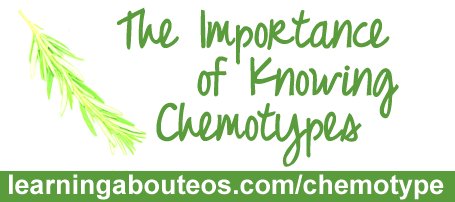
The Importance of Knowing Chemotypes
Some species of plants have the genetic ability to generate different chemical constituents due to the environment in which it resides. These different chemical types of the same genus and plant are called “chemotypes.” Knowing the chemotype of your essential oil is important, as they can contain different therapeutic properties and safety considerations.
Although not all plants have chemotypes, Rosemary is one that does. Rosmarinus officinalis is an example of a plant species that can provide different therapeutic properties depending on both the growing conditions and the country it is growing in.
To distinguish different chemotypes, the shortened form of “chemotype” is written as “ct.,” and then the name of the chemotype is presented at the end of the name. For example, the “camphor” chemotype is written as “Rosemary ct. camphor,” or when using the Latin name it is shown as, Rosmarinus officinalis ct. camphor.
Let’s take a look at Rosemary’s chemotypes and how they differ:
Rosmarinus officinalis ct. camphor – high in ketones, a good choice for muscle aches and pains. Diuretic properties, provides rheumatism relief, is a circulatory stimulant, anti-spasmodic, and breaks down mucous in the lungs. Ideal for adding to massage blends.
Rosmarinus officinalis ct. 1,8-cineole – high in oxides, making a great pick for respiratory issues due to its ability to reduce mucous. Antifungal, antibacterial, and antiviral; increases cerebral blood flow; anti-spasmodic; and decreases inflammation. Another perk about this chemotype is that it works well as a skin penetration enhancer. This chemotype is the best of all three for respiratory issues. It would also be great added to your shampoo and massaged into the scalp to both restore vitality and increase blood flow to the brain.
Rosmarinus officinalis ct. verbenone – high in ketones as well as monoterpenes. Verbenone is an excellent cell regenerator for the skin, is anti-spasmodic, and is good at combating respiratory issues at the same time. Best choice for skin. Since it is less “stimulating” than the other two types, verbenone is your chemotype of choice for night-time.
Thyme is another example. Thymus vulgaris ct. thymol is excellent for killing bacteria and viruses, but can be very irritating to the skin if not properly diluted. It is not a good idea to inhale this chemotype or use long-term.
Thymus vulgaris ct. linalol, on the other hand, is also anti-infectious, but is not irritating to the skin and can be used long term.
If you are looking for a chemotype that provides a specific therapeutic property, be sure you check the label carefully to see if the chemotype is identified. If not, find the website of the brand you purchased, and see if you can find it there. Reputable companies always provide this information, as they realize the value of knowing the difference between chemotypes.
Excerpt taken from the e-report, Using Essential Oils Safely. FREE when you sign up for our newsletter here.
| Lea Harris is a Certified Aromatherapist with Advanced Graduate training from Aromahead Institute in July 2013, but she is not a doctor. Please consult a trained aromatherapist or your doctor before using any of the suggestions on this website, as the user's age and health conditions must be taken into account before using. The information contained in this website is for informational purposes only, and should not be used as a substitute for professional medical advice. |


Comments
Powered by Facebook Comments